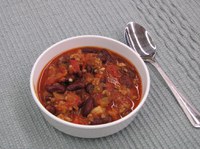Prairie Fare: Try These Tips, Resources for a Healthier New Year
(Click the image below to view a high-resolution image that can be downloaded)
By Julie Garden-Robinson, Food and Nutrition Specialist
NDSU Extension Service
The other day I stumbled upon a piece of food-related literature my husband bought for me several years ago. It caught his eye on a newsstand.
In an article that included compelling pictures, an eyewitness reported the furry and ferocious Bigfoot’s amazing weight loss. The creature apparently dropped from 800 pounds to 650 pounds by eating more berries, getting more physical activity, log rolling on a swamp and consequently, wrestling alligators.
Did I mention that my husband has a unique sense of humor?
Unfortunately, there was not an official diet and exercise plan. I’ll summarize the take-home message from what Bigfoot allegedly did to shed his excess 150 pounds. Bigfoot ate more fruits and vegetables and got more physical activity.
Really, that’s pretty good advice, except for wrestling alligators in swamps. Now you don’t need to buy the publication. Besides, I probably have a collector’s item because the tabloid no longer exists.
We have lots of health-related information coming our way but you need to consider the recommendations carefully. If you are thinking about getting healthier, the NDSU Extension Service can help you with evidence-based materials.
We are launching a brand new effort called “Nourishing Boomers and Beyond.” Although the primary target audience includes adults 50 and older, any adult can benefit from the content available on the website at http://www.ndsu.edu/boomers.
You can sign up for a free monthly newsletter and take part in online lessons. Rural counties in the central to western part of North Dakota will be offering face-to-face classes. You can learn about the particular counties offering the classes by visiting the website.
Here are 10 tips to a healthier 2014:
- Get to know the foods you eat. Get tips and support for making better food choices from your local Extension Service office.
- Take your time. Be mindful to eat slowly, enjoy the taste and textures, and pay attention to how you feel. Use hunger and fullness cues to recognize when to eat and when you’ve had enough. Remember, your brain needs at least 20 minutes to get the message that your stomach is full.
- Use a smaller plate at meals to help with portion control.
- If you eat out, choose more healthful options. Check and compare nutrition information about the foods you are eating. Most fast-food restaurants post nutrition facts on their menus. Better yet, preparing food at home makes controlling what is in your meals easier to do.
- Satisfy your sweet tooth in a healthful way. Indulge in a naturally sweet dessert – fruit! Serve a fresh fruit cocktail or a fruit parfait made with yogurt. For a hot dessert, bake apples and top with cinnamon.
- Choose to eat some foods more or less often. Choose more vegetables, fruits, whole grains, and fat-free or 1 percent milk and dairy products. Cut back on foods high in solid fats, added sugars and salt.
- Find out what you need. Get your personalized plan at http://www.choosemyplate.gov.
- Sip smarter. Drink water or other calorie-free beverages or fat-free milk when you are thirsty.
- Compare foods. Compare Nutrition Facts labels at the grocery store.
- Make treats “treats,” not everyday foods. Have a smaller piece, and limit sweet treats to special occasions.
This week’s featured recipe includes budget-stretching, fiber-rich beans and lean protein from a turkey. Protein and fiber help build satiety. You can prepare this chili recipe on a stovetop or in a slow cooker. By the way, I didn’t get this recipe from the Bigfoot article.
Turkey* Chili
1 Tbsp. olive oil or canola oil
1 yellow or white onion, chopped
1 green bell pepper, chopped
2 cloves garlic, chopped
1/2 pound ground turkey
2 Tbsp. tomato paste
1 tsp. ground cumin
2 tsp. chili powder
1 (28-ounce) can diced tomatoes
2 (15-ounce) cans cannellini or kidney beans, drained and rinsed
1/2 c. water
1/4 tsp. pepper
1/4 c. reduced-fat sour cream (optional)
Cilantro sprigs for serving (optional)
Heat oil in a large saucepan over medium-high heat. Add onion, bell pepper and garlic. Cook, stirring occasionally, just until vegetables are tender. Add turkey and cook, breaking up with a spoon, until no longer pink. Stir in tomato paste, cumin and chili powder. Cook and stir for one minute. Add tomatoes (with liquid), beans, water and pepper. Bring to a boil. Reduce heat and simmer, stirring occasionally, until slightly thickened, 12 to 15 minutes. Serve with sour cream and cilantro, if desired.
Makes eight servings. Each serving has 170 calories, 3 grams (g) of fat, 13 g of protein, 23 g of carbohydrate, 7 g of fiber and 300 milligrams of sodium.
(*)You can substitute other types of meat, such as lean ground beef or sausage.
(Julie Garden-Robinson, Ph.D., R.D., L.R.D., is a North Dakota State University Extension Service food and nutrition specialist and professor in the Department of Health, Nutrition and Exercise Sciences.)
NDSU Agriculture Communication – Dec. 26, 2013
| Source: | Julie Garden-Robinson, (701) 231-7187, julie.garden-robinson@ndsu.edu |
|---|---|
| Editor: | Rich Mattern, (701) 231-6136, richard.mattern@ndsu.edu |


